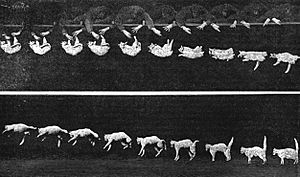Cat righting reflex facts for kids
The cat righting reflex is a special ability that helps cats land on their feet when they fall. It's like a built-in superpower! This amazing reflex starts when kittens are about 3 to 4 weeks old. By the time they are 6 to 7 weeks old, they have fully learned how to do it. Cats can do this because their backbone is very flexible, and their clavicle (collarbone) doesn't move much. For most cats, they need to fall at least 12 inches (about 30 cm) for this reflex to work safely.
Even cats without a tail can do this trick. This is because a cat mostly uses its back legs to twist itself around. It doesn't need much angular momentum (a spinning force) from its tail to get ready for landing. So, a tail isn't really needed for this cool skill.
Thanks to this righting reflex, cats can often land without getting hurt. However, this isn't always true. Cats can still get injured from very high falls.
In a 1987 study, published in the Journal of the American Veterinary Medical Association, scientists looked at 132 cats that had fallen from buildings. The study found that cats falling from higher places (up to seven stories) tended to have more injuries. But, surprisingly, for falls above seven stories, the cats had fewer injuries. The people who wrote the study think that after falling about five stories, cats reach their terminal velocity. This means they stop speeding up. At that point, the cats seemed to relax and spread out their bodies. This helps them increase drag (air resistance) and slow down their fall.
How Cats Twist in Mid-Air
First, cats figure out which way is up or down. They do this by looking around or by using special senses in their inner ear. Then, cats manage to twist their bodies to face downward. They do this without changing their overall angular momentum (their spinning motion). They follow these steps:
- They bend in the middle. This allows the front half of their body to turn in the opposite direction from the back half.
- They pull their front legs in close. This makes the front half of their body easier to turn.
- They stretch out their back legs. This makes the back half of their body harder to turn. Because of this, they can turn their front half a lot (up to 90 degrees). At the same time, the back half turns much less (as little as 10 degrees) in the opposite direction.
- They then stretch out their front legs and pull their back legs in. This lets them turn their back half quite a bit, while their front half turns less in the opposite direction.
If a cat isn't flexible enough (able to bend easily), it might need to repeat steps two and three to completely right itself.
Why Cats Survive High Falls
Besides their amazing righting reflex, cats have other body features that help keep them safe during a fall. Their small size, light bones, and thick fur all help to decrease their terminal velocity. This means they don't fall as fast as heavier animals. Also, once they have twisted to land on their feet, they can spread out their body like a parachute. This increases air resistance (drag) and slows down how fast they are falling even more. They also tend to relax as they fall, which can protect them a bit when they finally land.
Related Pages
Images for kids



